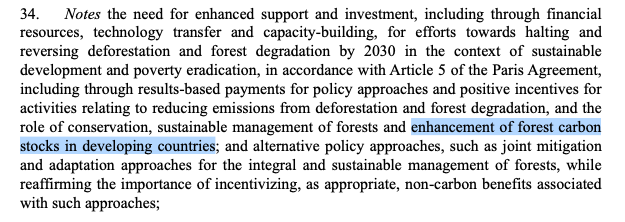
When going into COP28, my eyes were on three agenda items most likely to provide further guidance on carbon removal, carbon capture and carbon markets — the first global stocktake, markets under Article 6 of the Paris Agreement, and the mitigation work programme. This blog post explores the outcome of the international climate negotiations at COP28 on these topics.
Next to the formal negotiations COP28, we saw unprecedented action through the launch of a long list of initiatives that complement the negotiation process and showcase strong commitment among governments and non-state actors on climate change mitigation, including on carbon removal.
The Global Stocktake
The global stocktake process was a possibility to get better recognition and more explicit guidance on the role of carbon removal in climate change mitigation and how it’s presented in the next round of national climate pledges — Nationally Determined Contributions (NDCs) — due in 2025.
Another anticipated element was language on fossil fuels and the possibility of defining what “abated” means when referring to unabated fossil fuels. The carbon capture community was keeping a very close eye on these developments.
The outcome includes a reference to fossil fuels but uses the “transitioning away” language whilst limiting the reference to energy systems.
The chapeau of the section below reads “calls on Parties to contribute to the following global efforts“, and the list includes language on emission reduction (abatement) and removal technologies. Parts of the carbon removal community find it unhelpful that removals and carbon capture and storage (CCS) are bundled together. CCS on a cement plant reduces emissions, and CCS on a waste-to-energy plant can lead to carbon removal. So, this point refers narrowly to the carbon management technologies.

There is more on carbon removal in the Global Stocktake decision. Ocean-based carbon removal methods are covered in a separate point.

Terrestrial and marine ecosystems and forest carbon stocks are mentioned in points 33 and 34.


Carbon markets get a reference in point 31, although the incapability of the countries to agree on getting the UN carbon crediting mechanism under Article 6.4 up and running limits the action for now to the bilateral cooperation under Article 6.2. Whilst the reference to markets makes up only part of the sentence, its impact shouldn’t be underestimated. It confirms that carbon markets are sorely needed to deliver on the Paris Agreement temperature goal.

Something for the carbon removal community to look forward to is the next round of long-term strategies. The global stocktake decision urges countries to send in their revised long-term strategies by COP29.
All in all, the global stocktake decision includes a clear reference to CCS and the role of carbon markets and a non-exhaustive patchwork of references to different activities that can entail carbon removal. It could have been worse, but one can hope that by the next global stocktake, the urgency around removals has increased further and the guidance will get more specific and streamlined.
Mitigation Work Programme
The Mitigation Work Programme is somewhat less known among stakeholders who don’t follow the negotiations in detail. It was established at COP26 to “urgently scale up mitigation ambition and implementation in this critical decade” to help reach the temperature goal of the Paris Agreement. That is important for CCS, given the long lead times of the projects, and for removals due to the need to scale them up rapidly to have the right capacity available when needed.
This year, the mitigation work programme negotiations were careful not to duplicate the global stocktake discussions. The end results include a mention of carbon capture and use (CCU) and CCS.

It is surprising to see CCU come before CCS, given that the latter is expected to have a larger climate impact. But it’s the mention that counts and can be built upon.
As I mentioned above, CCS technology can reduce emissions (CCS on a cement plant) or remove carbon (CCS on bioenergy plants or waste-to-energy plants). Hence, this reference to CCS could be interpreted as a reference to carbon management more broadly.
Why are these references in decision texts important?
Looking at the often difficult-to-understand negotiation texts and such general references to different mitigation actions one may wonder if it even matters. Isn’t this all way too general to make a difference in climate action on the ground?
It’s all part of the negotiation process. And “in the UNFCCC negotiations, the process is the substance” — by now, a well-known phrase to explain the relevance. Once there is a mention in the text, it doesn’t disappear or change; it can be built upon and referred back to in future decisions. It serves as a hook for future negotiation progress but also for non-state actors who are launching their own complementary activities.
In short, every word matters and has a broad impact beyond this one piece of text. That is why the negotiations are so time-consuming.
Carbon Markets under Article 6
By far the most significant disappointment came in Article 6 negotiations, where no decisions were agreed upon for Article 6.2 and Article 6.4. There was a long list of topics to be discussed and decided upon.
Last year, the Article 6.4 Supervisory Body did not have the time to prepare their guidance on methodologies and was only able to agree on a 3-pager on removals that went on to be rejected at COP27. The Supervisory Body spent 2023 putting in countless days of discussions to agree on documents that could have a reasonable chance of getting approved. The additional meeting right before COP28 delivered the expected outcome – recommendations on methodologies and removals.
My expectation was that the recommendation on methodologies had a reasonable chance to be adopted, and that would have meant operationalising the Article 6.4 Mechanism. The chances of recommendation on removals seemed uncertain. However, certain negotiators packaged documents on methodologies and removals together and as a result, neither got adopted. The Article 6.4 Mechanism will miss at least one more year before becoming operational.
What does this mean for carbon markets?
It’s disappointing news. The more time is lost with getting the UN-led mechanism up and running, the less likely it will serve as the leading international standard for high-quality carbon markets. The longer it takes to operationalise the Article 6.4 Mechanism, the more countries will move on with their own frameworks.
The bilateral trading under Article 6.2 is, for now, the only operational part of international carbon markets and may keep that role for the foreseeable future. The convergence of different types of carbon markets will continue, even without the 6.4 Mechanism. There is plenty of action under Article 6.2, including several announcements during COP28.
What’s next?
It will be a busy year ahead, leading to COP29 in Baku, which is expected to be slightly less important given it’s between “the global stocktake” COP28 and the “ambition” COP30 in Brazil, where the next round of NDCs is due.
After eight years of underwhelming progress on international carbon markets, the expectations remain low. 2024 should be used to bridge the gaps in positions that led to the unfortunate outcome at COP28 and build a foundation to deliver solid decisions at COP29.
***
Thank you for reading! Sign up for updates below, and stay tuned for the next posts.
Would you like to use (parts of) the text? Go ahead on the condition that you explicitly refer to this post and include a link.
Thank you!

